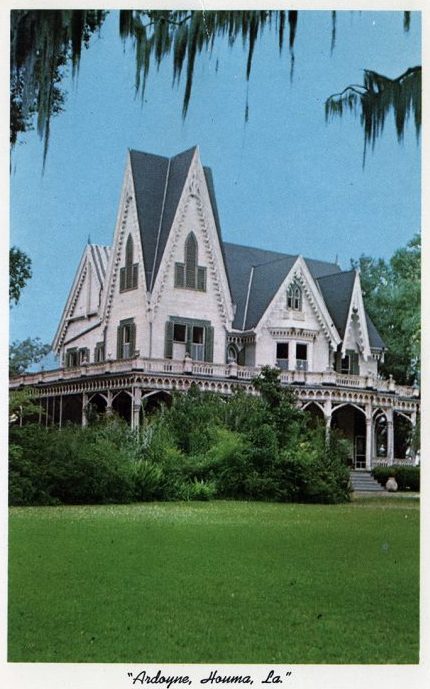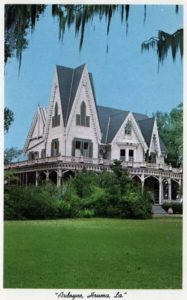Ardoyne Plantation
Ardoyne is the most elaborate and romantic-looking Gothic Revival residence surviving in Louisiana.

Courtesy of The Historic New Orleans Collection
Ardoyne Plantation. Unidentified
Described in a 1894 publication as “a specimen of pure rural Gothic architecture and a fine type of the ideal country home,” Ardoyne is the most elaborate and romantic-looking Gothic Revival residence surviving in Louisiana. The house is situated on Little Bayou Black, between Houma and Schriever in Terrebonne Parish.
Sugar planter John Dalton Shaffer hired the Williams brothers from New Orleans to design the house while his wife was in Europe. According to family tradition, Ardoyne (little knoll) was designed after a Scottish castle that Shaffer had seen in a magazine. Pointed-arched bargeboards adorn the dramatically steep gables of the cypress-wood house, echoing the Spanish moss trailing from the surrounding oak trees. The window openings are also pointed arches, and hood molds further emphasize the attenuated shape. A gallery encompasses the front and sides of the house, and a gabled tower rises from the octagonal first floor to a square-shaped second floor. Although the exterior conveys a strong impression of asymmetry, the house has a central-hall plan on both floors and is two rooms deep, with a two-story rear wing. The twenty-one rooms include seven bedrooms and twelve fireplaces, with original, hand-stamped wallpaper in the entrance hall as well as original chandeliers and gasoliers. The wooden stairs, balustrades, and mantels are quite elaborate, as was typical of late nineteenth-century Arts and Crafts interiors. Rooms are still furnished with antiques that belonged to the Shaffer family and their relatives.
The house, which is listed on the National Register of Historic Places, opened to the public for tours in 2013. Items exhibited in the home include collections of Louisiana Native American baskets, Newcomb pottery, and tokens used as scrip to pay the migrant German, Italian, and African American workers who labored on the sugar plantation.
Adapted from Karen Kingsley’s Buildings of Louisiana, part of the Buildings of the United States series commissioned by the Society of Architectural Historians and published by Oxford University Press.
